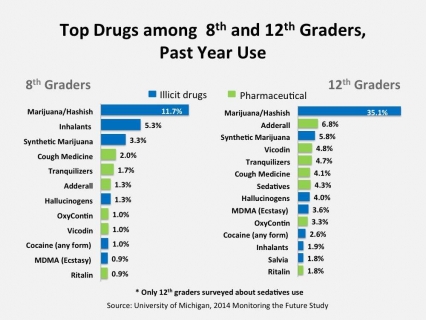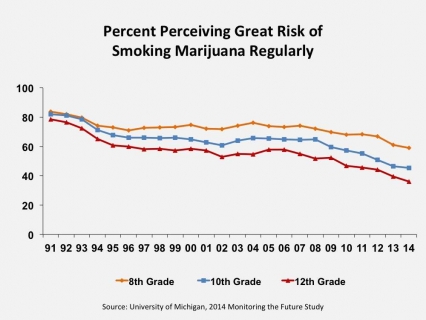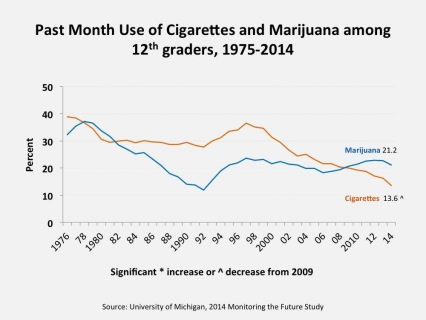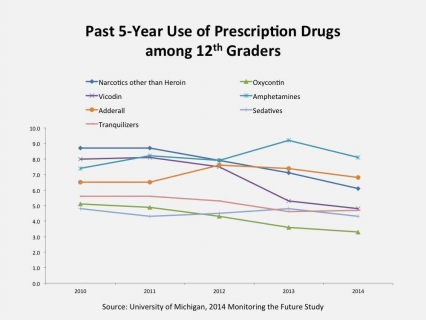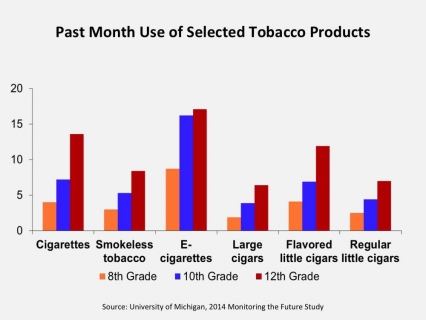This year’s Monitoring the Future Survey of drug use and attitudes among American 8th, 10th, and 12th graders continues to show encouraging news, with decreasing use of alcohol, cigarettes, and misuse of prescription pain relievers; stable rates of marijuana use among teens; decreasing use of inhalants and synthetic drugs, including K2/Spice and Bath Salts; and a general decline over the last two decades in the use of illicit drugs. However, the survey highlighted growing concerns over the high rate of electronic cigarette use and softening of attitudes around some types of drug use, particularly decreases in perceived harm and disapproval of marijuana use.
The Good News
- Abuse of prescription and over-the counter drugs continued to decline in among the nation’s youth. Past year use of the opioid pain reliever Vicodin showed a significant 5 year drop, with 4.8 percent of 12th graders using Vicodin for non-medical reasons, compared to 9.7 percent in 2009. Past year use of narcotics other than heroin (which includes all opioid pain relievers) among high school seniors showed a significant drop to 6.1 percent from 7.1 percent a year ago and from 9.5 percent at the peak in 2004. Past year non-medical use of the stimulants Adderall and Ritalin (often prescribed for ADHD) remained relatively steady, at 6.8 percent and 1.8 percent respectively for high school seniors. The survey continues to show that most teens get these medicines from friends or relatives and to a lesser degree, from their own prescription from a previous medical issue. There was also a significant drop in the past year use of cough/cold medicines containing dextromethorphan (DXM) among 8th graders, with only 2 percent using them for non-medical reasons, down from 2.9 percent last year and 3.8 percent five years ago.
- Likewise, 5-year trends continue to show significant decreases in alcohol use among all grades. 9.0, 23.5 and 37.4 percent of 8th, 10th and 12th graders respectively reported past month use of alcohol, compared to 14.9 percent, 30.4 percent and 43.5 percent in 2009. There was also a significant drop in binge drinking in 2014 among high school seniors, which is now under 20 percent after peaking in 1998 at 31.5 percent. The binge drinking rate represents the percentage of students who reported consuming 5 or more drinks in a row sometime in the last two weeks.
- Cigarette smoking has decreased markedly over the past 5 years (almost 50%) across all grades and is currently at its lowest rate in the survey’s history. Daily cigarette smoking decreased to 1.4 percent among 8th graders compared to 2.7 percent five years ago; to 3.2 percent among 10th graders, compared to 4.4 percent last year, and 6.3 percent five years ago; and to 6.7 percent among high school seniors, down from 8.5 percent last year, 11.2 percent in 2009, and nearly 25 percent at the peak in 1997.
- Marijuana use did not increase despite softening of perceived risks. Past month use of marijuana remained steady among 8th graders at 6.5 percent, 10th graders at 16.6 percent and 12th graders at 21.2 percent. Close to 6 percent of 12th graders report daily use of marijuana. 81 percent of high school seniors say it is easy to get marijuana. Among 8th graders, there was a drop in perceived availability, with 36.9 percent saying it is easy to get marijuana, compared to last year’s 39.1 percent.
- The survey also revealed that marijuana is frequently consumed as an edible, which is more prevalent among states with medical marijuana; specifically of the12th graders who consumed marijuana in the past year 40% of them reported having consumed it in an edible form in the medical marijuana states versus 26% in non-medical marijuana states. In 2014 there was no significant difference in the rates of marijuana use among high school seniors in medical marijuana states compared to non-medical marijuana states (34.5 and 30.1 respectively); this is in contrast to 2013 when 40.4 percent of high school seniors in medical marijuana states reported smoking marijuana in the past year compared to 29.7 percent in non-medical marijuana states.
- Use of illicit drugs has generally declined over the past two decades. Past year use of illicit drugs for all grades combined now sits at 27.2 percent, down from its peak in 1997 at 34.1 percent. Past year use of MDMA (also known as ecstasy or “Molly”) saw a significant decline among 10th graders to 2.3 percent, from 3.6 percent in 2013, now just about one third of the 2001 peak level of 6.2 percent. Past year use of heroin remained very low despite increased use among adults over 26 years of age[1] in 2013.
- There has been a considerable decline in past year use of K2/Spice (sometimes called “synthetic marijuana”) in the two years the survey has been tracking its use. 5.8 percent of 12th graders reported its use this year, compared to 7.9 percent last year and 11.3 percent in 2012. This was associated with an increase in the perceived risk of taking synthetic marijuana once or twice among 12th graders. Use of the hallucinogen salvia also dropped significantly among 12th graders in the past year to 1.8 percent, from 3.4 percent in 2013.
- Past year use of the amphetamine-like stimulants known as bath salts (added to the survey in 2012) remained low, and dropped considerably among 8th graders, to 0.5 percent compared to 1 percent last year.
- Use of inhalants is at its lowest levels in the history of the survey, among 10th and 12th graders. Rates of inhalant use are traditionally highest among 8th graders (unlike most other drugs. Past year use among this age group is at 5.3 percent, down from 8.1 percent five years ago and 12.8 percent at its peak rate in 1995.
- The survey also shows a decline in the perceived availability of most substance over the past few years including alcohol, cigarettes, marijuana, powder cocaine, crystal methamphetamine, and prescription painkillers.
Areas of Concern
- Measured for the first time in the MTF survey this year, the use of electronic cigarettes (e-cigarettes) is high among teens with 8.7 percent of 8th graders, 16.2 percent of 10th graders, and 17.1 percent of 12th graders using e-cigarettes in the past month. Only 14.2 percent of 12th graders view regular e-cigarette use as harmful. The nicotine in e-cigarettes is vaporized and inhaled (not smoked), however, the health impact of e-cigarette use is not yet clear, nor is it known if use of e-cigarettes increases the likelihood of transitioning to conventional cigarettes or other tobacco products. While many of these student e-cigarette users have a history of cigarette and/or smokeless tobacco exposure, approximately 2.9% of 8th graders, 4.5% of 10th graders and 3.8% of 12th graders report past month use of e-cigarettes while denying ever using tobacco cigarettes or smokeless tobacco.
- While marijuana use has remained relatively stable over the past few years there continues to be a changing of attitudes about the perceived risk of harm associated with marijuana use. The majority of high school seniors do not think regular marijuana smoking is harmful, with only 36.1% saying that regular use puts the user at great risk compared to 52.4 percent five years ago. However, 56.7% of seniors say they disapprove of occasional marijuana smoking, and 73.4 percent say they disapprove of regular marijuana smoking, down from 65.6 percent and 80.3 percent respectively in 2009. Eighty-one percent of seniors say it is easy to get marijuana.
- Marijuana use continues to exceed cigarette use in all three grade levels. In 2014, 21.2% of high school seniors used marijuana in the past 30 days compared with 13.6% who smoked cigarettes.
- Past-year hookah use continued to increase among 12th graders to 22.9%—the highest rate since 2010, when the survey started capturing this type of tobacco use.
- Changing attitudes toward substance abuse often precede changes in reported use. The perceived risk of harm of regularly smoking marijuana and taking prescription stimulants including amphetamines has continued to decline among 12th graders. This is evidenced by a 5 year decline in the perceived harm of regularly smoking marijuana from 52.4 percent in 2009 to 36.1 percent in 2014 and a decline in the perceived harm of regularly taking prescription amphetamines from 69.0 percent in 2009 to 55.1 percent in 2013. This could indicate that use of these drugs could begin to rise again in future years.
Videos
- Transcript: Animated Infographic: Monitoring the Future 2014 Survey Results
-
Text Description of Infographic
Monitoring the Future is an annual survey of 8th, 10th, and 12th-graders conducted by researchers at the University of Michigan, Ann Arbor, under a grant from the National Institute on Drug Abuse, part of the National Institutes of Health. Since 1975, the survey has measured drug, alcohol, and cigarette use and related attitudes in 12th-graders nationwide. Eighth and 10th graders were added to the survey in 1991. Overall, 41,551 students from 377 public and private schools participated in the 2014 survey.
First figure: Last Two Decades of Alcohol, Cigarette, and Illicit Drug Use*
*Past 30 day use.
This graphic illustrates past 30 day alcohol, cigarette, and illicit drug use among 8th, 10th, and 12th graders from 1994 through 2014. Alcohol and cigarette use have generally decreased over the last two decades. Illicit drug use declined in the early 2000s, increased in 2011, but has remained steady or decreased somewhat in more recent years.In 2014, past 30 day use in each category was:
Alcohol
12th graders: 37.4%
10th graders: 23.5%
8th graders: 9.0%Cigarettes
12th graders: 13.6%
10th graders: 7.2%
8th graders: 4.0%Illicit Drugs
12th graders: 23.7%
10th graders: 18.5%
8th graders: 8.3%Second figure: Teens are more likely to use e-cigarettes than cigarettes.
* Past month use8th grade
Cigarettes: 4.0%
e-Cigarettes: 8.7%10th grade
Cigarettes: 7.2%
e-Cigarettes: 16.2%12th grade
Cigarettes: 13.6%
e-Cigarettes: 17.1%Only 14.2% of 12th graders view e-cigarette use as harmful, which is less than 5 students in the average class.
Third figure: Almost two-thirds (64%) of high school seniors do not view regular marijuana use as harmful compared to just over one-third (35%) 20 years ago. Marijuana use has remained relatively stable among high school students over the past few years. 56.7% of high school seniors say they disapprove of occasional marijuana smoking.
Forth figure: Prescription/Over-the-Counter vs. Illicit Drugs
After marijuana, prescription and over-the-counter medications account for most of the top drugs abused by 12th graders in the past year.This list shows the percentage of 12th graders who have used the following drugs in the past year.
Prescription
Adderall – 6.8%
Vicodin – 4.8%
Tranquilizers – 4.7%
Cold Medicines – 4.1%
OxyContin – 3.3%
Ritalin – 1.8%Illicit Drugs
Marijuana – 35.1%
K2/Spice (“synthetic marijuana”): 5.8%
MDMA/Ecstasy: 3.6%
Cocaine: 2.6%
LSD: 2.5%Fifth figure: Cigarette smoking and binge drinking are down over the last decade.
The number of students who disapprove of regular smoking and binge drinking increased in 2014, and 8th and 10th graders report that cigarettes and alcohol are becoming harder to get.For more information, visit us @NIDAnews
The National Institute on Drug Abuse is a component of the National Institutes of Health, U.S. Department of Health and Human Services. NIDA supports most of the world’s research on the health aspects of drug abuse and addiction.
Audio
MK2 - Move Out. Free Music Archive Creative Commons
- Transcript: Dr. Nora Volkow Discuss MTF 2014 Results
-
[Music]
Dr. Nora Volkow speaking:
The Monitoring the Future this year is getting on some very good news.
Because what it's showing is that the prevalence of illicit drug use among teenagers is actually going down across a wide variety of illicit substance.
It's also very good news because it’s also showing us decreases in the pattern of licit drug use, and that is tobacco and alcohol.
What the new Monitoring the Future is telling us in that the rate of marijuana use has not increase among 8th, 10th and 12th graders.
It seems to have been stabilized.
I think relates to all of the indicators, that is, lifetime exposure to regular use.
We're seeing interestingly that the number of teens that perceive the use of marijuana as dangerous, whether it occasional or regular is going down and that is quite significant.
We’ve seen these pretty significant changes over the past five years less and less kids are viewing the use of marijuana ask harmful.
What's interesting is at the same time we're seeing seen very quite high levels consistent of disapproval of the use of marijuana.
Also an area where we are seeing very good news then we've actually had started to see them in the past few years a significant decrease in particular, are the most dramatic as it relates to the abuse of pain medications.
So, over the past five years we've seen almost a 50 percent decrease in the rates of the abuse of the pain medications that contain opiates, which are actually highly addictive drugs that also are dangerous because of the risk of overdoses.
What it is important to recognize is that we cannot become complacent and also identified that these indicators going in the right direction reflect the fact that prevention works.
[Music]
- Transcript: Dr. Wilson Compton Discuss MTF 2014 Results
-
Dr. Wilson Compton speaking:
Tobacco use rates in the Monitoring the Future study have reached their lowest level than we have ever seen in the history of the study.
So this means that for instance current use of tobacco is under 15 percent for the 12th graders.
That's a marked improvement from the 40 or 50 percent rate that we saw a number of years ago.
When we look at heavier daily use of tobacco those rates also are at the lowest levels we have ever seen in this study.
So this speaks to us about the importance and the success of our prevention efforts when it comes to controlling this extraordinarily deadly tobacco product.
For the first time, Monitoring the Future Study includes questions about the use of e-cigarettes.
These are quite different from the use of combustible or smoked tobacco cause the are those electronic nicotine delivery systems.
We were quite surprised to see that a large number of youth are not only using these but even among youth that have not previously smoked cigarettes, there is a significant number using e-cigarettes.
For instance about 8 percent overall of 8th graders report use of these electronic cigarettes in the past month.
And about half of those had never used another kind of cigarette before, so this is perhaps a concerning exposure to nicotine at quite a young age.
[Music]
- Transcript: Teen Drug Use: 2014 Monitoring The Future Survey Results
-
Dr. Johnston speaking:
This is the 40th year of the Monitoring the Future study.
We started in 1975, we look at 8th, 10th and 12th grade students every year and what we've seen this year is actually pretty good news for the country I think.
We’re seeing no substance is going up in use, a number going down, a other ones holding steady.
Importantly among those going down I think are cigarettes, which have been in decline for some years amongst teenagers and that drop in use is going to be very important in the healthy longevity of this generation of young people.
In a particular, of course is the concern of narcotic drugs, which account for a great many overdose deaths.
The use of narcotics has been declining over the last few years and continue this year and the overall use of prescription drugs in general is in decline.
So I think those are important developments. Almost all the news is good, the one fly in the ointment is e-cigarettes.
Dr. Miech speaking:We found in 2014 the 30-day use of e-cigarettes is higher than the use of regular tobacco cigarettes.
In fact, among eighth and tenth graders, we asked them in the past 30 days have they used an e-cigarette, and have they used tobacco cigarettes.
We find that the number reporting using an e-cigarettes is more than twice as high, as a number that is used a tobacco cigarette.
Of particular interest what we found was that a substantial number about 7 percent of 10th grade of people who are using e-cigarettes had never used a regular tobacco cigarette in their lives.
So it's hard to make a case for these people that they're using e-cigarettes as a way to quit regular tobacco smoking because they’ve never smoked tobacco in their life.
The message here for educators and for the public health field is that many youth are initiating nicotine use with e-cigarettes and nicotine use is of course addictive, physically addictive.
So we're gonna ask kids now the surveys in the field for next year, “Do they know what is in the e-cigarette to the smoking nicotine, are they smoking marijuana or hashish oil?”
We don't know yet, this was, 2014 was the first year we asked but the e-cigarettes and because we felt such alarmingly high prevalence we've added new questions this year to get at those kind of questions.
Additional Graphs
References
[1] Substance Abuse and Mental Health Services Administration, Results from the 2013 National Survey on Drug Use and Health: Summary of National Findings, NSDUH Series H-48, HHS, Publication No. (SMA) 14-4863. Rockville, MD: Substance Abuse and Mental Health Services, Administration, 2014.

